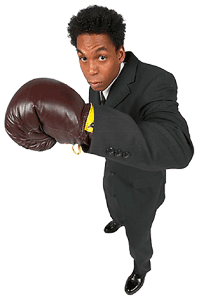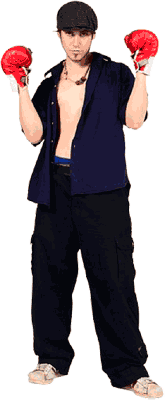Lungs-Largeintestines - Stomach-Spleen - Heart-Smallintestine - Unitarybladder-Kidneys - Pericardium-Tripleheaters - Gallbladder-Liver
 |
 |
 |
 |
About Boxing
Boxing is a full contact sport or an exercise programme that can be used as a way to physical health and well being. For the boxer that fights, boxing is an athletic full contact form of martial arts contest that could end in knockout or severe physical damage.
For the exercise boxer, boxing can offer fitness, friendship with a fun exercise routine.
Boxers are recognized because they wear boxing gloves on their fists during a fight (although many other forms of martial arts have now adopted glove wearing also) and abide by a strict set of regulated rules during a contest. Most boxing clubs cultivate a friendly vibrant atmosphere with everyone aiming to get fit, learn to box and progress in their skills. if you attend a boxing club expect people to be friendly, courteous and helpful.
And always remember that meditation has traditionally been the cornerstone to any good martial art.
History
Boxing has probably been around since the 3rd century BC as the earliest boxing reference is depicted on a Sumerian stone carving relief. Ancient references to boxing carry on up to and through the height of the Rome Empire until the Roman gladiator period when boxing was deemed too brutal and was abolished because boxers would be expected to fight to a bloody death which was expensive for the owners of the boxers, because the boxers were usually expensive highly trained slave stock.
Boxing could have been a way for fighter to win their freedom, some boxers eventually becoming citizens of Rome through their fighting skillsand famous fights.
Boxing for most fighters (of this period in time) has been a way for the masters of slave boxers, or the Roman slaves themselves to achieve a high status in society or make a lot of money very quickly if they were good at their trade. Money making or a way to achieve what the boxer wants has always been a motivating factor for the boxer, modern or ancient.

Bare knuckle fist fighting
flourished in the period between the Roman ban and up to the 17th century, which was when fighting was first called by the name of boxing.
The first boxing contest had no rules and no weight divisions until 1743 when boxing champion Jack Broughton introduced a set of boxing rules to give some protection to the fighters. Broughton also promoted the first boxing gloves of this time. Through Broughton's rules fighters were disallowed to grasp below the waist or hit a man when he was down, although eye gouging, head butting, punching, throwing and choking was common practice during a boxing match.
London prize ring rules were introduced to boxing in 1838 (revised in 1853) where fights would be contested in a 24 foot square ring surrounded by ropes, a fighter had to rise up under his own power within 30 seconds of being knocked down
or lose the contest, hitting below the belt, biting and head butting were made illegal.
In 1867 under the patronage of the Marques of Queensbury rules
were formulated by John Chambers for an amateur boxing contest to include weight divisions consisting of lightweight, middleweight and heavyweight, held at Lillie bridge in London, and because of the Marques association these rules have always been known the Marques's of Queensbury rules.
Bare knuckle fighting continue to flourish although it was outlawed in England and a large proportion of the USA.
In 1882 bare knuckle fighting finnaly met its match over the case of the Crown v Coney where the Crown found against Coney for assault occasioning actual bodily harm
regardless of the other fighters consent.
1882 saw the first legitimate heavyweight world championship fight using the Queensbury rules between
John L. Sullivan and Gentleman Jim Corbett at the Pelican club in New Orleans.
Boxing had finally come of age through the use of the Queensbury rules which have been modified from time to time to modernize boxing, but is the historic backbone for legitimate boxing as we now know it.
Amateur v Professional boxing
Amateur boxers tend to wear head gear, fight durations are shorter and are stopped more quickly if someone is out-boxed than a professional fight.
Professional boxers tend not to wear head gear, the fights have more rounds, which mean they go on for longer ,and the fighters are allowed to carry on fighting for longer than an amateur fighter should they get hurt.
Modern professional boxers usually start out as an amateur boxer, joining a club and learning the difference between a left hook from a right uppercut. If an amateur boxer shows promise they will be chosen to fight for their club in tournaments first at a local level then at a county level until they have shown enough skill to fight in the ranking amateur contests to decide the best fighter around. During the time a fighter is on the rise in the amateur world the fighter will be constantly training, watching their diet, getting enough sleep and working on their skills to become the best they can be at their sport. Indeed, boxing is very competitive and only the best reach the top and to reach the top takes dedication, skill and talent.
Once a fighter has won all they can win as an amateur, and has learned the boxing trade it is usually deemed time to acquire a good manager and turn professional.
Although an amateur boxer can now earn a good living from sponsorship, amateurs in the past had to become a boxer off their own back; holding down a job to earn a living whilst learning to box.
Becoming Professional:
After years of coming up through the ranks skilled professional boxers can earn the respect of other boxers and boxing fans worldwide, breakdown racial barriers and earn the boxer serious life changing amounts of money just for one fight. This makes boxing very attractive to the up and coming fighter, it could mean escaping poverty or a mundane existence whilst doing the sport they love as a job.
Brawler: Will take a lot of punishment but given the opportunity will give it out, they tend to be hard hitting, moving forward with very little mobility.
Counter Puncher: Can block a punch then retaliate with a counterpunch straight away, good at evading an attack from any direction. A good counter-puncher must be accurate and able to read what punch is coming to react-counter straight away.
Puncher: An all round good boxer who knows their trade using good techniques and a combination of close fighting and distance fighting with the power to knockout the opponent with one blow.
Out Fighter: Uses footwork to evade, stays out of reach, has fast hands and reflexes. This type fighter will maintain distance and wear his opponent down whilst ducking and evading attacks will skillfully move around the ring scoring points to win the fight on a decision but still sometimes winning on a knockout.
Swarmer or In Fighter: Continually hitting the opponent "Swarming them" whilst bobbing and weaving all the time to slip punches. Swarmers tend to fight in close.
Recognize a style: Some boxers like to stick to one style whilst others have the ability to change styles at will. Boxers who can work out the opponents boxing style then you can find a way to perhaps beat them. Sometimes though it really does not matter what style a fighter adopts, because they are so good at boxing no-matter what style of boxing they change to or use, they win.
about acupuncture about reflexology about aromatherapy about weight management about traditional Chinese medicine about yin&yang about the five elements about the three treasures about zang fu about meridians
about capoeira - about chi gong - about fencing - about hapkido - about jeet kune do - about judo - about ju jitsu - about karate - about kendo - iaido - jodo - about kickboxing - about kung fu - about krav maga - about mma - about ninjutsu - about mauy tai boxing - about taekwondo - about tai chi - about wing chun - about boxing - about aikido









